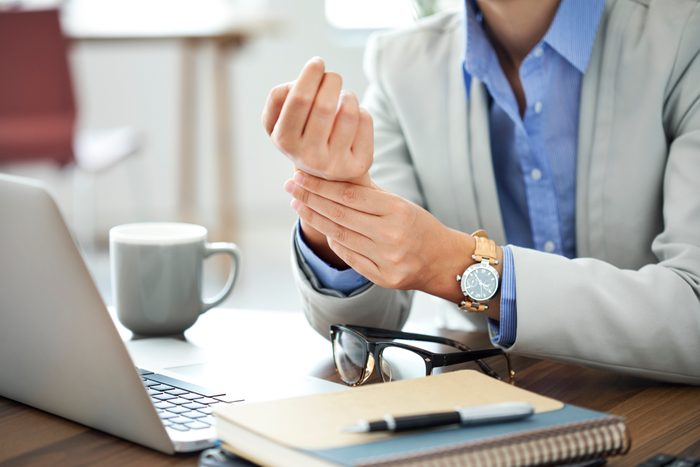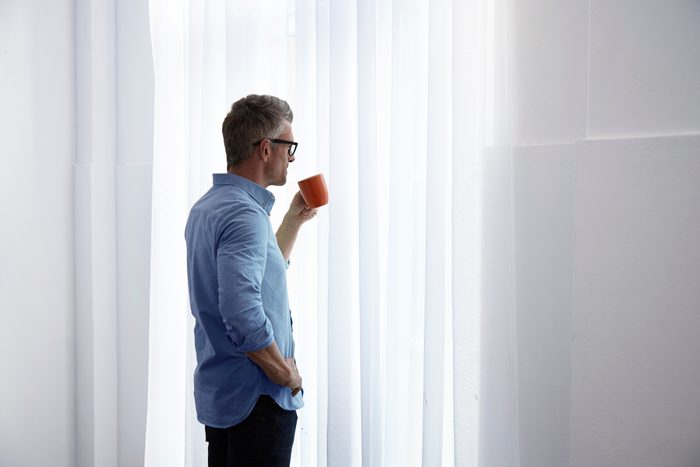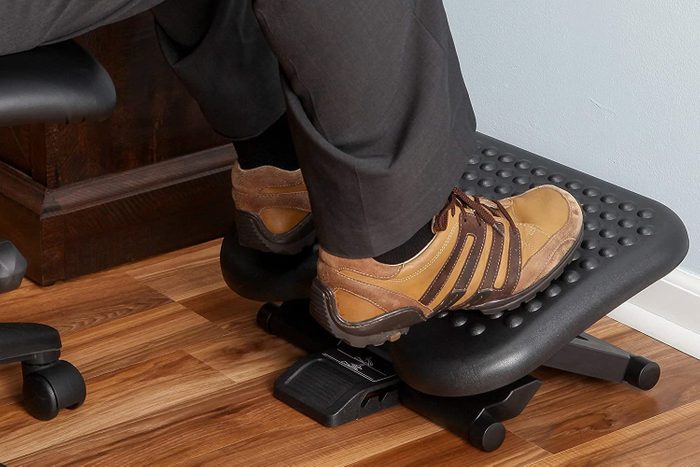How to avoid arthritis pain at work
If you’ve ever felt joint stiffness, tight hips, or lower back pain after a long day of work, you’re not alone. Sitting at a desk all day every day isn’t necessarily a good thing for anyone. Even if you don’t have arthritis, sitting too much or too long is thought to be bad for your health. However, there are 54 million adults in the U.S., or 23% of people, who have arthritis, according to the Centers for Disease Control and Prevention. The joint condition can be so painful that about 8 million of those people find that it interferes with their ability to work. In fact, arthritis is the leading cause of work disability.
There are many different types of arthritis, including osteoarthritis, rheumatoid arthritis, gout, and lupus, among others. While the causes and symptoms for each type of arthritis varies, they all can cause stiffness; aching, painful joints; and swelling. If you do have arthritis and find sitting at a desk for long periods of time difficult, here are some expert tips that might help.

What sitting does to the body
“In a nutshell, sitting causes the body to weaken,” says Charles Kim, MD, physiatrist and pain management specialist at the Joint Preservation & Arthritis Center at NYU Langone Health. When you’re not moving around during the day and simply sitting for hours on end, many of your muscles, bones, and supporting structures aren’t being used and can lose strength.
Cartilage, which cushions the joints and is worn down in osteoarthritis, doesn’t have any blood vessels in it, so the only way it gets nourishment is when you apply small amounts of impact, says C. Kent Kwoh, MD, chief of the division of rheumatology at the University of Arizona College of Medicine in Tucson and director of the University of Arizona Arthritis Center. “You need to move around to get it the nutrition it needs and flush out waste products,” Dr. Kwoh says.
In addition, sitting all day (especially with poor posture) can cause back issues. “Sitting, by its nature, is putting more stress on the discs in the spine,” says Dr. Kim. In particular, when you sit you flex your spine—aka, bend forward—and doing that for too long can put extra pressure on the discs, leading to lower back pain.
Finally, sitting with your hips and knees bent in the same position all day long keeps the joints and supportive structures (ligaments, muscles, etc.) under constant tension and can cause stiffness and discomfort.

Why sitting is difficult if you have arthritis
Those impacts of sitting all day are magnified for people with arthritis. For some, it can be so bad that they have trouble holding down a job. “If you have arthritis, it makes it a lot tougher to maintain being productive and active, and it can be harder to keep a job if there isn’t some amount of flexibility,” says Dr. Kwoh.
The impacts vary a bit by the type of arthritis you have, though many overlap. Rheumatoid arthritis (RA) is an autoimmune disease marked by inflammation in the joints and other parts of the body. It causes pain, redness, swelling, and warmth, Dr. Kwoh explains. Generally, it affects small joints in the hands (knuckles, wrists) and feet. With RA, staying still for too long causes the joints to really stiffen up, and it can take a while for that to go away once you start moving again. (Here’s what you should know about using CBD for rheumatoid arthritis.)
Osteoarthritis (OA), on the other hand, is called “wear and tear” arthritis, or arthritis of old age, says Dr. Kwoh. (Here’s the difference between osteoarthritis and rheumatoid arthritis.) There’s usually some low-grade inflammation involved, too. It’s most common in weight-bearing joints, like the back, hips, and knees. It can also develop in joints that have been injured in the past, Dr. Kwoh says. It’s less common in the wrist, and when it shows up in the hands, it tends to be in the joints closest to the nails and at the base of the thumb. While some stiffness can occur, osteoarthritis is better known for causing pain when there’s too much stress on the affected joints.
While some lifestyle modifications—including regular exercise and weight loss (if your arthritis is in weight-bearing joints)—can help you manage arthritis, there are also some simple things that you can do at work to minimize arthritis-related stiffness and pain, no matter which type of arthritis you have.

Set up an ergonomic workstation
“In both types of arthritis, you really need a good ergonomic workstation,” Dr. Kwoh says. “The keyboard should be at a height where your hands are down and elbows are flexed but not elevated too high. Your shoulders should be relaxed, elbows bent at about 90 degrees, and your wrists should be flat and not bent.” Ideally, you should have a neutral neck and be able to just gaze down a bit with your eyes at the screen to avoid straining your back, neck, and shoulders. (Here’s more detailed information on how to optimize your desk setup.)
It’s OK to change things up a bit to make them most comfortable for you, though, says Lorie Y. Barker, an occupational therapist and an instructor of occupational therapy at Colorado State University in Fort Collins.
For example, you may want to push the keyboard a little away from you to open up the arms and have the elbows at a wider angle. “The best thing is to not be putting pressure on the elbows or the wrists,” Barker says. Avoid resting your wrists on the keyboard or your elbows on armrests for a long period of time. “People tend to rest on the elbow joint where the nerve is and that causes more problems.”
Putting a pillow or chair cushion behind your back can also help support the spine if you have back arthritis.

Change positions frequently throughout the day
“The bottom line is you have to move around,” says Dr. Kim. “Don’t sit all day, don’t stand all day. Moving around is best.” Every 30 minutes to an hour, change positions, even if it’s a tiny adjustment. This will help keep your joints from getting stiff or enduring too much pressure in one area or position. The key is to avoid maintaining a static posture all day long, says Barker.

Walk and stretch regularly
Keep moving, even on the bad days, says Barker. If your joints are feeling good, move more. But on bad days, it’s still important to get up and move all the joints through whatever range of motion is comfortable at that time. (These chair stretches might help.) Just make sure you’re staying within a pain-free zone, she adds. “Typically you can find that mid-range that feels OK but if you push beyond that, you can start to have some pain.” Moving will help keep the joints from getting too stiff. It’s also important to gently stretch and twist the spine, in particular, to get the blood flowing and balance out the flexed-back position, Dr. Kim says.
If you’re not sure what movements are safe for you, talk to your doctor or physical therapist.
Quick note: With osteoarthritis, the joints typically hurt more when you use them and feel better with rest, but you have to remember that sitting isn’t necessarily resting, Dr. Kowh notes. “Sitting can be putting a lot of stress on different joints,” especially the back. Changing positions and getting up to walk frequently can help relieve some of that pressure.

Request a “sit and stand” desk
Standing desks were all the rage for a while, but the truth is, you’ll gain the most from an adjustable desk that lets you seamlessly alternate between sitting and standing, like this TechOrbits Standing Desk Converter. Standing all day comes with its own challenges, especially for people with joint pain. What Dr. Kim suggests is asking for a desk setup that lets you alternate, because that seems to be better than spending all day doing just one or the other. Again, experts agree that changing positions is always better than keeping your joints in one static position for hours on end.
You may need a doctor’s note to request an appropriate desk setup, and some workplaces may make it harder to get one than others. If you are able to get one, don’t forget to readjust your screen and equipment when you change positions, says Barker. An anti-fatigue mat may also offer more comfort and support. And for when you’re sitting, make sure your chair is supportive, like with these office chairs for back pain.

Use extra layers to keep joints warm
Cold weather seems to make arthritis joints more symptomatic, Barker says. Science doesn’t really know why this is, but many people with arthritis report their joints ache more when it’s cold out.
If this is something you notice that impacts you, Barker suggests simply being proactive. “Try to have some extra layers you can take on and put off, or use a little space heater if it’s allowed in your workspace.” This extra heat may help your joints feel a little less stiff and make your workday a little more comfortable.

Set up something to rest your feet on
If your hips or knees hurt from being forced into the same bent position all day, find a footrest, like this Adjustable Under Desk Foot Rest, that you can prop your feet up on. Then, alternate between having your feet on the platform and on the ground, suggests Barker. “This will just change the degree of stress on the joints over time,” she explains.

Buy thicker pens and pencils
If you have arthritis in your hands, look for writing utensils with a wider barrel, Barker suggests. “Some thin, narrow pens are hard to get a good grasp on. These won’t do your joints a favor.” Bigger writing utensils allow you to have a more comfortable grip that doesn’t require as much tension to hold on effectively. This one from Thixotropic has lots of glowing reviews from people with arthritis.
Use the same concept for any other equipment you use. Any time you can alter a handle so that your grasp can be wider can really take the stress off the hand joints, Barker says.

Try using an ergonomic mouse
Another thing that can be helpful for hand arthritis? A differently sized mouse. “There are a ton of mouses out there,” says Barker. One that’s vertical or wider may be easier for you to grasp comfortably, like this Nulaxy 2.4G Wireless Vertical Ergonomic Mouse. A trackball mouse may also be a more comfortable alternative. “You can use your thumb on the rollerball as a mouse instead of moving your hand around with a standard mouse, which is really nice if people want to explore options to get out of their usual hand positions,” Barker says. Try the Logitech MX Ergo Wireless Trackball Mouse.

